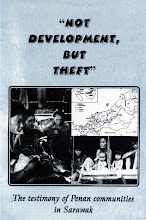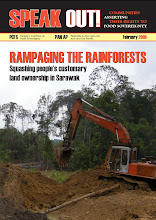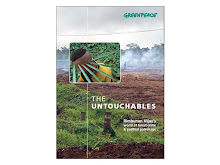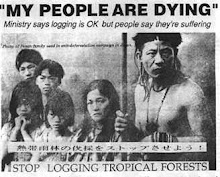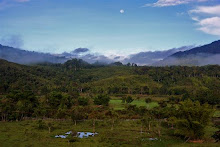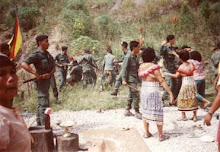FACT SHEET
BARAM HYDRO-ELECTRIC DAM PROJECT
The Sarawak Government plans to build more hydro-electric dams purportedly to meet the state’s future industrialisation needs. In addition to the Bakun dam project, the Sarawak Government are planning to build another 12 hydro-electric dams at Ulu Air, Metjawah, Belaga, Baleh, Belepeh, Lawas, Tutoh, Limbang, Baram, Murum and Linau rivers including an extension to the Batang Ai Dam.
Sarawak Energy Berhad (SEB), 65 percent owned by the Sarawak is spearheading these dam projects.
The project
The Batang Baram is the second longest river in Sarawak. The river drains much of the Sarawak northern region as it originates in the central Iran Mountains at the Sarawak/Malaysia-Kalimantan/Indonesia border. It flows westwards through tropical rainforest in the Baram District to the South China Sea. The Miri Resort City is located at Baram delta.
The Baram Hydroelectric dam site is located along Baram River at about 306 Km from the river mouth. The location of the dam across the Baram River will be between the inflows of the Sungai Patah and Sungai Kahah from the left and Sungai Hit from the right, as going upstream.
The height of the main Baram dam would be 162 m above foundation level. The dam structure across the Baram River has a crest length of 685 m and the crest level is 180 m above sea level. The construction would be designed as a roller-compacted concrete (RCC) gravity dam. Due to the topographical conditions in the project area, a 70m high Saddle dam will be constructed approximately 5 Km south-west of the project site.
Who will be affected by the Baram dam?
If the project goes ahead, an anticipated number of at least 20,000 indigenous peoples will be affected and displaced by the dam. These peoples are the Kayans, Kenyahs and Penans whose longhouses and villages are situated along the course of Baram River valley, locally known as Telang Usan. Their settlements are located below, above and around the project site.
The downstream longhouses/villages are Long Laput, Sungai Dua, Sri Kenawan, Uma Bawang, Long Miri (Daleh Pelutan), Long Pilah and Long Kesseh. In the upstream and within the dam reservoir area are Long Na’ah, Long Liam, Long San, Long Selatong (Kiri & Kanan), Long Apu, Long Julan Asal, Long Julan Pelutan, Long Anap, Long Palai, Long Je’eh, Long Moh, Long Sela’an and Long Semiyang as well as some villages in Akah River that are Long Beku, Ba Abang, Long Tap and Long Tebangan.
The Baram dam would submerge an area of 38,900 hectares (389 sq km) of land and forest. The area is mostly native customary land, and consists of temuda, cultivated lands, gardens, villages, churches, graveyards, community forests and sites of historical significance. The people are going to lose their longhouses, villages, properties, lands and forests as a result of submergence and displacement by the Baram dam.
The construction of the Baram dam will create a catchment area of 896,600 hectares (8,966 sq km). Within the catchment area are some major settlements of indigenous communities: the Kenyahs, Kelabits, Sabens and Penans.
The dam will submerge the existing government schools, Medical clinics, airstrip and other building facilities. There are also logging companies actively operating in the area.
Baram Dam Project Features:
Main dam
Type RCC
Crest of dam 180 m a.s.1.
Height of dam 162 m
Length of dam 685 m
Saddle dam
Type Rockfill
Crest of dam 180 m a.s.l.
Height of dam 70 m
Length of dam 1,290 m
Reservoir
Normal water level 178 m a.s.1.
Minimum water level 177 m a.s.1.
Total storage volume 13,2 x 109 rn3
Reservoir area 389 sq km
Power plant
Installed capacity 830 MW
Design discharge 684 m3/s
Design head 138 m
Average energy generation 5,848 GWh/a
Turbine type Francis –vertical axis
Number of units 4
Catchment Areas 8,966 sq km
FACT SHEET
THE MURUM HYDROELECTRIC PROJECT
WHAT AND WHERE IS IT?
The Murum hydroelectric project (Murum HEP) involves the construction of a 944 MW hydroelectric dam. The dam is the 1st of 12 new more dams to be built by the State Government of Sarawak. The construction work of the dam has been going on since mid-2008. The dam site is on the Murum River, a tributary of Balui River, about 60 KM upstream of the Bakun Hydroelectric project in Belaga District, Kapit Division of Sarawak.
PHYSICAL FEATURES
The Murum dam is a 141-metre-high Roller-Compacted Concrete (RCC) dam that would be 547 metres above sea level, with a length of crest of 510 metres and crest width of 10 metres. It will flood 24,5000 hectares of land comprising native customary land and forest. The dam catchment area is 275,000 hectares of mainly the Usun Apau Plateau, the ancestral land of several Indigenous communities in Sarawak.
WHO IS AFFECTED?
The project will inundate and require the forced relocation of about 1,000 Penans. There is also some Kenyah-Badengs, who were affected by Bakun dam but have opted for alternative resettlement after refusing to move to the government Bakun Resettlement Scheme at Asap-Koyan in upper Belaga River in 1998.
WHO IS BUILDING IT?
The Sarawak Government has the sole vested interest, being the project proponent and the Sarawak Energy Berhad (SEB), 65 percent owned by the Sarawak state. The Murum Dam project had been awarded to China’s Three Gorges Project Corporation, which reportedly submitted the lowest bid among eight companies.
The estimated cost of Murum dam project is RM3 billion (875 million USD). To be completed in 2013.
Kenyataan Akbar Penan Murum
Telang Usan Hotel
Kuching, Sarawak.
Tarikh: 15 September 2009
Salam hormat. Selamat pagi kepada tuan-tuan, puan-puan dan suadara-saudari kalian.
Saya bersama kawan-kawan sangat gembira kerana berpeluang dapat berjumpa dengan semua kalian pada majlis yang sangat bersejarah ini. Bagi kami, ini adalah kali pertama sampai ke Bandaraya Kuching.
Untuk makluman semua, kami adalah wakil semua penduduk kampung-kampung Penan di kawasan Sungai Peleiran-Murum, Daerah Belaga, Sarawak. Kampung kami adalah Long Wat, Long Luar, Long Tangau, Long Menapa, Long Singu, Long Malim dan Long Uba dengan bilangan penduduk adalah kurang lebih 1,000 orang.
Kami datang ke Bandaraya Kuching kali ini bukan datang dengan senang hati namun penuh dengan kebimbangan, kerisauan dan ketangisan. Kami membawa keluhan-keluhan hati semua penduduk kampung Penan di kawasan Sungai Peleiran kerana sangat bimbang dengan kehidupan kami sejak bermulanya kerja-kerja pembinaan projek empangan Murum dijalankan.
Sekiranya projek empangan Murum masih diteruskan, maka takungan air akibat empangan akan membanjiri tanah adat kami termasuklah kampung-kampung, harta benda, kebun-kebun, tanah huma dan temuda, buah-buahan, tapak perkuburan dan sebagainya. Kawasan hutan dan sumber-sumber yang mendukung kehidupan kami akan turut musnah. Sekaligus, kami akan dipaksa untuk berpindah ke suatu kawasan yang belum kami ketahui dan tidak bersesuaian dengan keadaan kehidupan kami.
Kami masyarakat Penan juga mahu mencapai kemajuan sepertimana masyarakat lain di Malaysia, khasnya Sarawak. Selama ini, kami sentiasa memohon kepada kerajaan untuk memberi projek pembangunan seperti Sekolah, Klinik Perubatan, Paip air bersih, Pertanian dan sebagainya. Kami tidak pernah memohon pembangunan projek empangan hidro-elektrik seperti empangan Murum.
Kami sedar bahawa projek pembangunan empangan yang telah dibina di Sarawak telah dengan nyatanya gagal memperbaiki keadaan hidup masyarakat yang terlibat. Contohnya, penduduk-penduduk di Skim Penempatan Semula Batang Ai dan Bakun Asap-Koyan sedang menghadapi banyak masalah, kesusahan dan kesempitan dalam kehidupan harian mereka yang sehingga kini masih belum dapat diselesai oleh pihak kerajaan.
Kami juga menyaksi bahawa keadaan kehidupan masyarakat Penan Talun, Long Belangan di Skim Penempatan Semula Bakun Asap-Koyan lebih teruk lagi dibanding dengan sebelum-nya mereka dipaksa pindah akibat pembinaan empangan hidro-elektrik Bakun.
Bagi kami masyarakat Penan di kawasan Sungai Peleiran-Murum juga akan tidak terkecuali dari masalah-masalah dan impak-impak projek empangan sekiranya kerajaan masih hendak meneruskan pembinaan empangan Murum.
Kami sangat bimbang akan kesan-kesan dan impak-impak projek empangan Murum ke atas masa depan masyarakat dan generasi kami.
Dengan ini, kami menuntut Kerajaan untuk menghentikan pembinaan empangan hidro-elektrik Murum demi kesejahteraan hidup masyarakat kami pada masa sekarang dan sehingga ke anak cucu kami kelak.
Sekian, terima kasih.
Kenyataan akhbar dibaca oleh:
Sui Along,
Wakil TK Along Ju dan 6 kampung Penan yang lain di kawasan Peleiran-Murum, Daerah Belaga, Sarawak.

 PUTRAJAYA, Sept 29 — A proposed RM50 billion takeover of Malaysia’s highway concessionaires has taken on a new twist with its promoters now cleared to brief Prime Minister Datuk Seri Najib Razak on their plans sometime this week.
PUTRAJAYA, Sept 29 — A proposed RM50 billion takeover of Malaysia’s highway concessionaires has taken on a new twist with its promoters now cleared to brief Prime Minister Datuk Seri Najib Razak on their plans sometime this week.








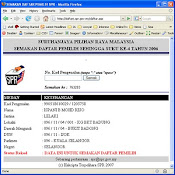


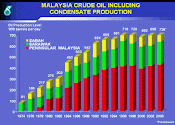














 Thus, even though the accursed Bakun dam had been suspended in 1997 due to the financial crisis, the government still went ahead to displace 10,000 indigenous peoples to the Sungai Asap resettlement camp in 1998.
Thus, even though the accursed Bakun dam had been suspended in 1997 due to the financial crisis, the government still went ahead to displace 10,000 indigenous peoples to the Sungai Asap resettlement camp in 1998. But the contracts for the resettlement scheme and the logging are chicken feed compared to the mega-bucks to be reaped from the mega-dams. Even before the Bakun dam ever got started, Malaysian taxpayers had to compensate dam builder Ekran Bhd and the other “stakeholders” close to RM1 billion in 1997.
But the contracts for the resettlement scheme and the logging are chicken feed compared to the mega-bucks to be reaped from the mega-dams. Even before the Bakun dam ever got started, Malaysian taxpayers had to compensate dam builder Ekran Bhd and the other “stakeholders” close to RM1 billion in 1997. In the early 90s, when the government was trying to assure us that there would be no irresponsible logging in Sarawak, I pointed out in Parliament that if the government could not monitor the Bukit Sungai Putih permanent forest and wildlife reserve just 10 minutes from Kuala Lumpur, how did they expect us to believe they could monitor the forests in Bakun?
In the early 90s, when the government was trying to assure us that there would be no irresponsible logging in Sarawak, I pointed out in Parliament that if the government could not monitor the Bukit Sungai Putih permanent forest and wildlife reserve just 10 minutes from Kuala Lumpur, how did they expect us to believe they could monitor the forests in Bakun? The undersea cable was again part of the project. There was also a plan for an aluminum plant, a pulp and paper plant, the world's biggest steel plant and a high-tension and high-voltage wire industry.
The undersea cable was again part of the project. There was also a plan for an aluminum plant, a pulp and paper plant, the world's biggest steel plant and a high-tension and high-voltage wire industry. Malaysian taxpayers, Malaysian forests and Malaysian indigenous peoples will again be the main victims of this misconceived plan. We have been told that some 1,000 more indigenous peoples will have to be displaced from their ancestral lands to make way for these two dams.
Malaysian taxpayers, Malaysian forests and Malaysian indigenous peoples will again be the main victims of this misconceived plan. We have been told that some 1,000 more indigenous peoples will have to be displaced from their ancestral lands to make way for these two dams. Right now, the country is being fed conflicting reports about energy demand.
Right now, the country is being fed conflicting reports about energy demand. Does it matter that the co-owner of one of the smelters is none other than Cahaya Mata Sarawak (CMS) Bhd Group, a conglomerate controlled by Taib's family business interest?
Does it matter that the co-owner of one of the smelters is none other than Cahaya Mata Sarawak (CMS) Bhd Group, a conglomerate controlled by Taib's family business interest? The social atrophy among the 10,000 displaced indigenous peoples at Sungai Asap resettlement scheme remains the wicked testimony of the Mahathir/Taib era. The empty promises and damned lives of the displaced peoples as forewarned by NGOs in 1999 have now been borne out.
The social atrophy among the 10,000 displaced indigenous peoples at Sungai Asap resettlement scheme remains the wicked testimony of the Mahathir/Taib era. The empty promises and damned lives of the displaced peoples as forewarned by NGOs in 1999 have now been borne out.





























